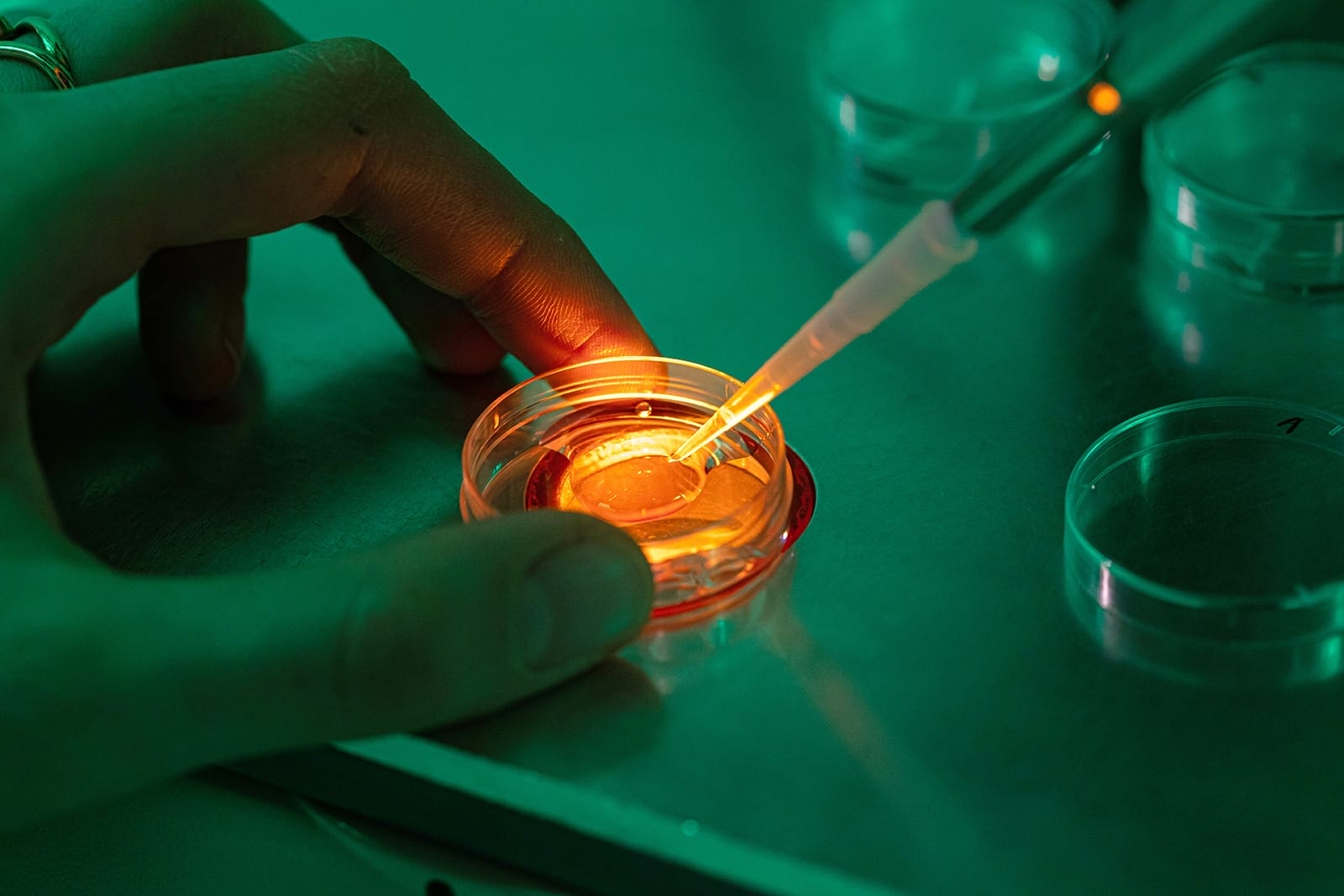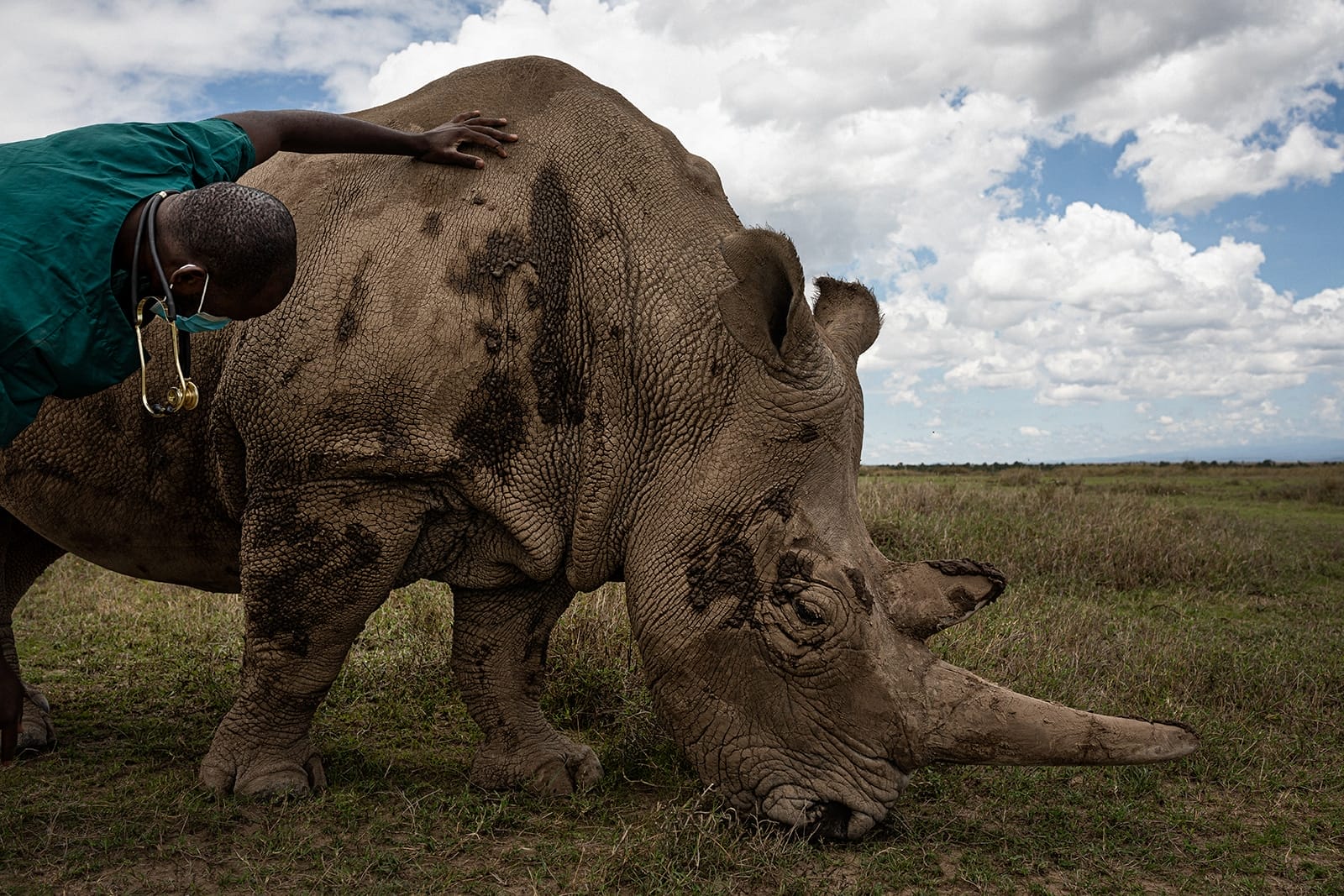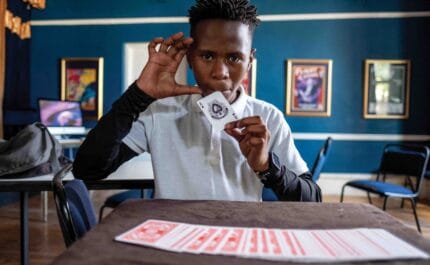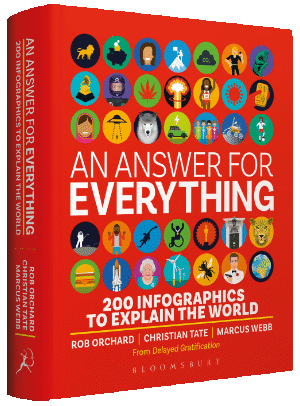Before you go
With only two creatures left on the planet, both female, it seems that the northern white rhino is destined for extinction, but an ambitious project hopes to bring it back from the brink. We travel to Kenya and Italy to document what could be a remarkable comeback
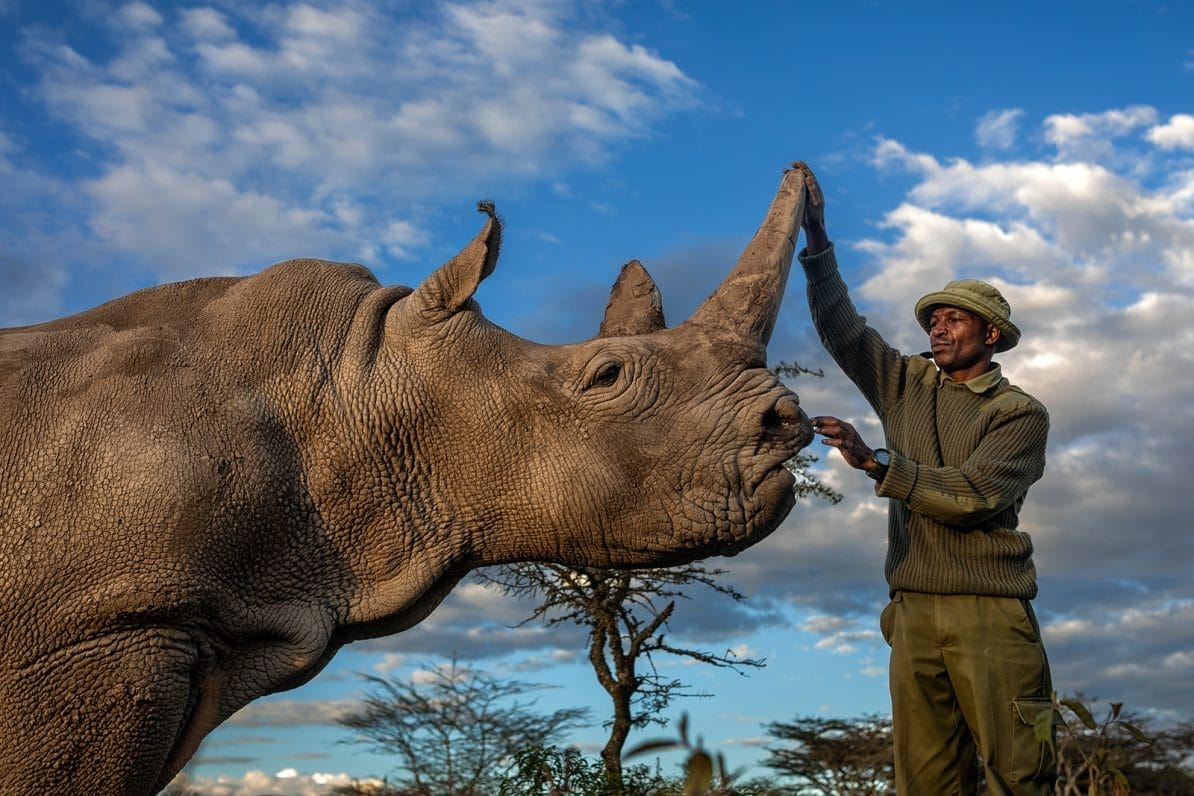
Zachary Mutai scratches the lip of Najin, one of the last two northern white rhinos left in the world, at the Ol Pejeta Conservancy, Kenya, April 2021
9th April 2021 (Taken from: #43)
Cesare Galli is holding a species’ last hope. In his lab in Cremona, northern Italy, the scientist beckons us closer and screws the lid off a liquid nitrogen canister. He affords us a glimpse at its precious cargo: a brace of northern white rhino embryos. Should the embryos develop into calves and make it to birth they would double the population of one of the world’s rarest animals.
Decades of poaching and habitat loss have reduced the numbers of northern white rhinos from a population of thousands to just two. As both remaining rhinos are female, Galli and BioRescue – the international consortium of pipette-wielding scientists and conservationists he works with – represent the only barrier between a creature that has walked the Earth for five million years and extinction.
Galli is the founder and director of Avantea, an Italian biotech firm specialising in advanced animal reproduction. His company was invited to participate in BioRescue – a collaborative project which also includes the Leibniz Institute for Zoo and Wildlife Research, the Dvůr Králové Zoo in the Czech Republic and Kenya’s Ol Pejeta Conservancy and is funded by the German government – on the strength of its two decades in elite horse reproduction.
Horses are the farm animals most closely related to rhinos, and Avantea’s lab was the first to artificially impregnate a mare using an embryo created through intracytoplasmic sperm injection (ICSI), the process of direct introduction of a sperm cell into the cytoplasm of an egg cell. ICSI is also the most widely used technique for artificially inseminating humans, and Galli has spent several years adapting the method for rhinos – first with the Sumatran and southern white varieties, before turning his attention to the precious northern white. He is in no doubt about the size or importance of the task. “When you eliminate a species from the ecosystem, you risk throwing everything off-balance,” he says. “They are also an iconic species.”
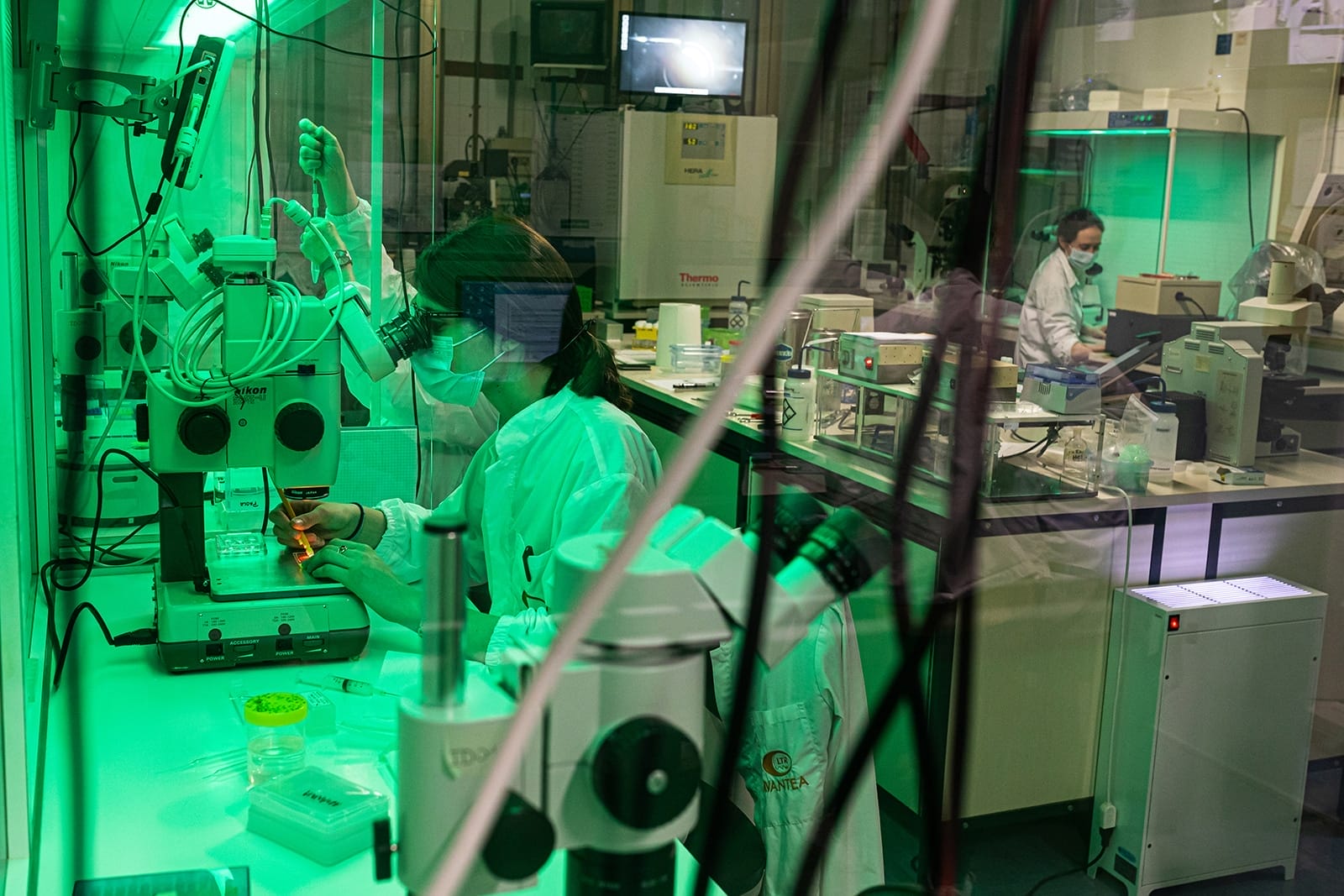
The Avantea laboratory in Cremona, Italy, where they have created northern white rhino embryos via artificial insemination
The ‘Adam’ in Galli’s petri dish conception is Suni, a male northern white rhino who died in 2014 but not before his sperm was extracted and frozen, hopefully allowing him to become a father from beyond the grave. The ‘Eve’, Fatu, is still with us – for now. The future of her kind now rests with her.
And then there were two
We are standing in front of the planet’s last pair of northern white rhinos. Najin and Fatu are mother and daughter. They are kept behind three electric fences at the Ol Pejeta Conservancy in central Kenya, protected at all times by a squad of armed rangers. Unperturbed by the wider implications of their imminent extinction, their days follow a simple and uneventful routine. They wake at around six each morning in their cosy, straw-bedded pen. For the next three hours they can be found grazing in their 2.8km-square enclosure. Once it gets too hot, they have their fill of water and lie down to rest, only to resume eating when the sun dips. Zachary Mutai, their head caregiver at the conservancy, describes them as “happy slaves of routine”. “Food is very important to them,” he says with a smile. “Bales of straw get Najin and Fatu through the dry seasons, while carrots are their favourite quick fix.”
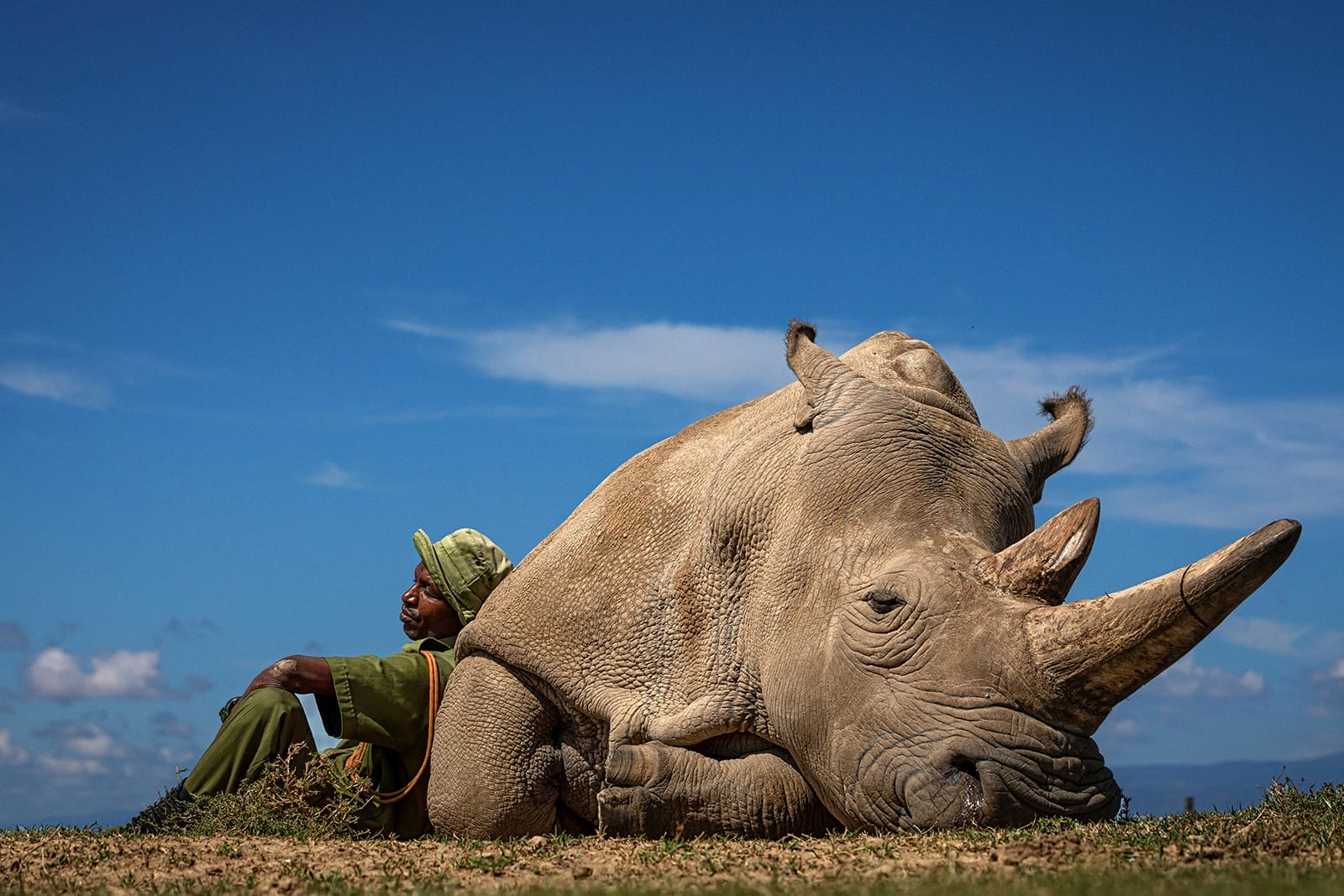
Najin and caretaker Zachary Mutai rest in the afternoon sun in Ol Pejeta Conservancy, 12th April 2021
Mutai’s affection for his wards is extraordinary to witness. Najin, who is 32, seems to adore him stroking her behind her ears and along her flank. The moods of Fatu – Najin’s 21-year-old daughter – are harder to predict, so he keeps her at a distance. It’s probably a wise tactic. As members of the second biggest land-mammal species on the planet, the “two girls” as they are affectionately known, could trample him in a heartbeat. But after years of spending more time with them than with his own family, Mutai seems unconcerned. He coos to them gently and enthusiastically narrates their every tic and habit to us. Even a burst of rhino flatulence prompts whoops of fatherly pride.
“I grew up north of the Masai Mara national reserve, where we had plenty of wild animals,” says Mutai, who can spot rhinos from more than a kilometre off without binoculars. “Ol Pejeta was previously a cattle ranch, where my father used to work. When the ranch started expanding into wildlife preservation, I jumped at the opportunity to get a job. At first I oversaw the electrical fence maintenance, but I rose to the position of head caregiver to the rhinos. I have been doing this for over ten years.” Our conversation is punctuated by the sound of lions roaring in a distant thicket, and monkeys gibbering nearby. Mutai directs our gaze to a flock of ostriches practising sprints.
Four northern white rhinos once roamed Ol Pejeta. Alongside Najin and Fatu were two males, Suni and Sudan, Najin’s father. All four transferred from Dvůr Králové safari park in the Czech Republic in 2009 in the hope that returning them to their natural habitat might help them regain their zest for life and reproduction. Very little went according to plan. The imported rhinos did mate, but no calves were born as a result. In 2014 Suni died of natural causes, aged 34. On 18th March 2018, Sudan, the last northern white male standing, collapsed and couldn’t get up. His severe pain forced the Ol Pejeta staff to put him to sleep the following day. To hear Mutai tell it, it was like their whole world went dark. “All of the caretakers were crying,” he says. “I was fortunate enough to spend his last moments by his side. He was a friend to so many people here.”
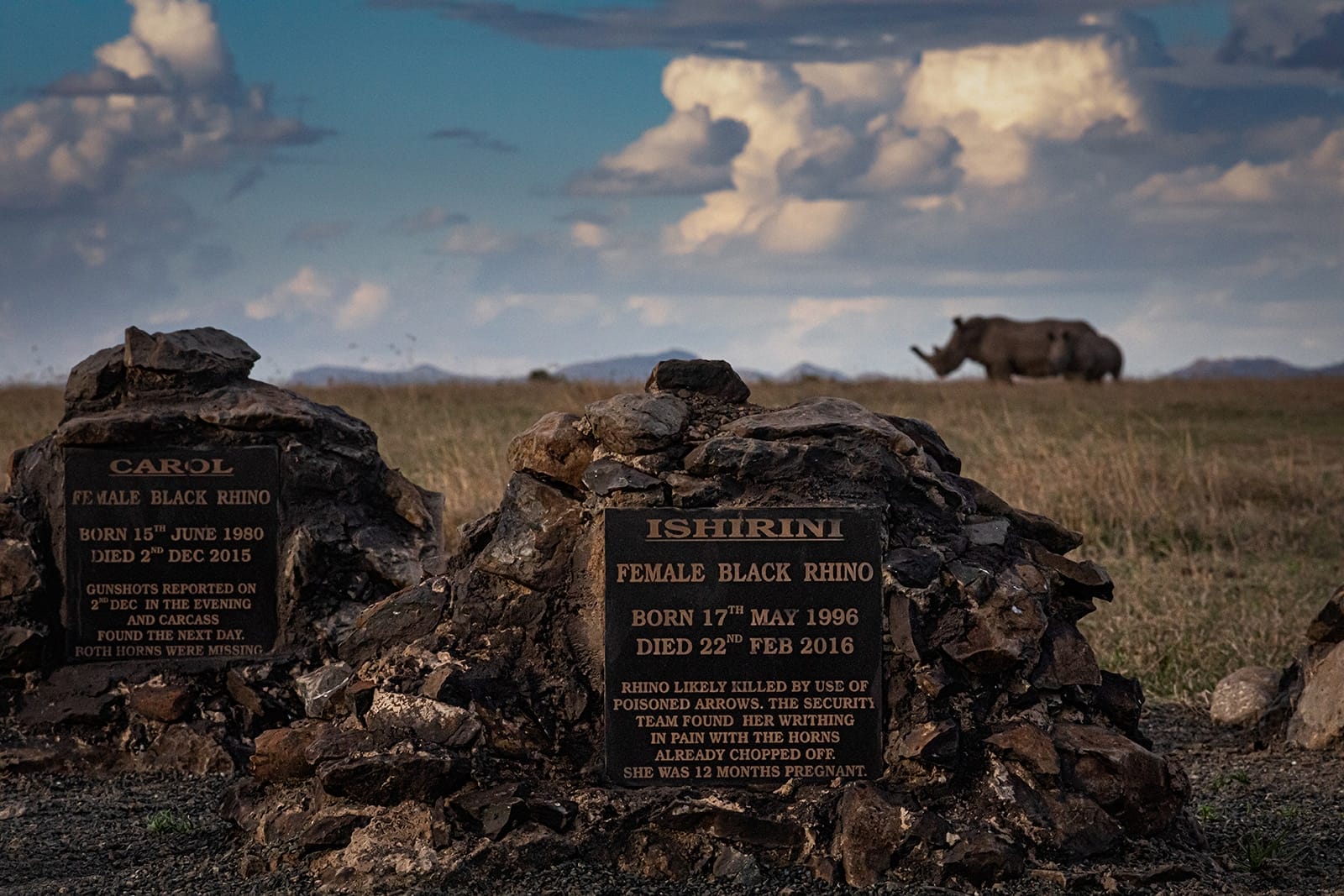
Gravestones in Ol Pejeta. Thanks to extensive security measures, the conservancy hasn’t lost a rhino to poaching in three years
With no males left, it’s up to science to step in, but harvesting oocytes, egg cells found in the ovary, from a rhino is a challenging endeavour. A rhino’s ovaries are not much larger than a human fist and are located at least one-and-a-half metres inside a female rhino, hidden behind intestinal loops. Two-inch-thick skin prevents them from being accessed surgically, so instead the BioRescue team have been forced to be creative. They have developed a tube equipped with a long needle which is inserted through the anus. The needle, which is connected to a suction device, pierces the ovaries and, once inside, sucks oocytes down the tube. One slip and you risk inflicting internal bleeding and halving the population of northen whites. And there’s a time limit. A rhino can only be safely sedated for two hours and would likely be none too pleased to wake up with an egg-sucking tube inserted in its anal cavity. Stephen Ngulu, head vet at Ol Pejeta, insists the procedure is safe. “The process has had no significant impact on the pair’s wellbeing,” he says.
After the previous oocyte collection in September 2020, the team decided it was too risky to attempt the procedure on Najin, the eldest northern white, again. She did not seem to have developed enough oocytes and her advanced age – rhinos have a life expectancy of 35-40 years in the wild – increased the level of risk. Fatu, her daughter, shows more promise. In early April 2021, 19 oocytes were retrieved from Fatu’s ovaries using a probe guided by ultrasound. The eggs-in-waiting were immediately whisked away on a helicopter to Nairobi airport and from there to Galli’s Italian lab.
Life on the ranch
Even before they began experimenting with IVF, Ol Pejeta had done a great deal to save the world’s rhinos, although it wasn’t always that way. In the mid-20th century it was a cattle ranch separated into several fenced-off plots where the livestock grazed. Any wildlife straying into the compound would be exterminated. But following Kenya’s 1977 ban on wildlife hunting, the animals – especially elephants – began returning to the area. With the additional financial strain these destructive interlopers put on the ranch, the decision was taken to branch out into tourism. In 1988, the ranch also became a reserve and was filled with critically endangered black rhinos. Its initial population of 20 has today grown to 145, making Ol Pejeta the largest black rhino sanctuary in east Africa.
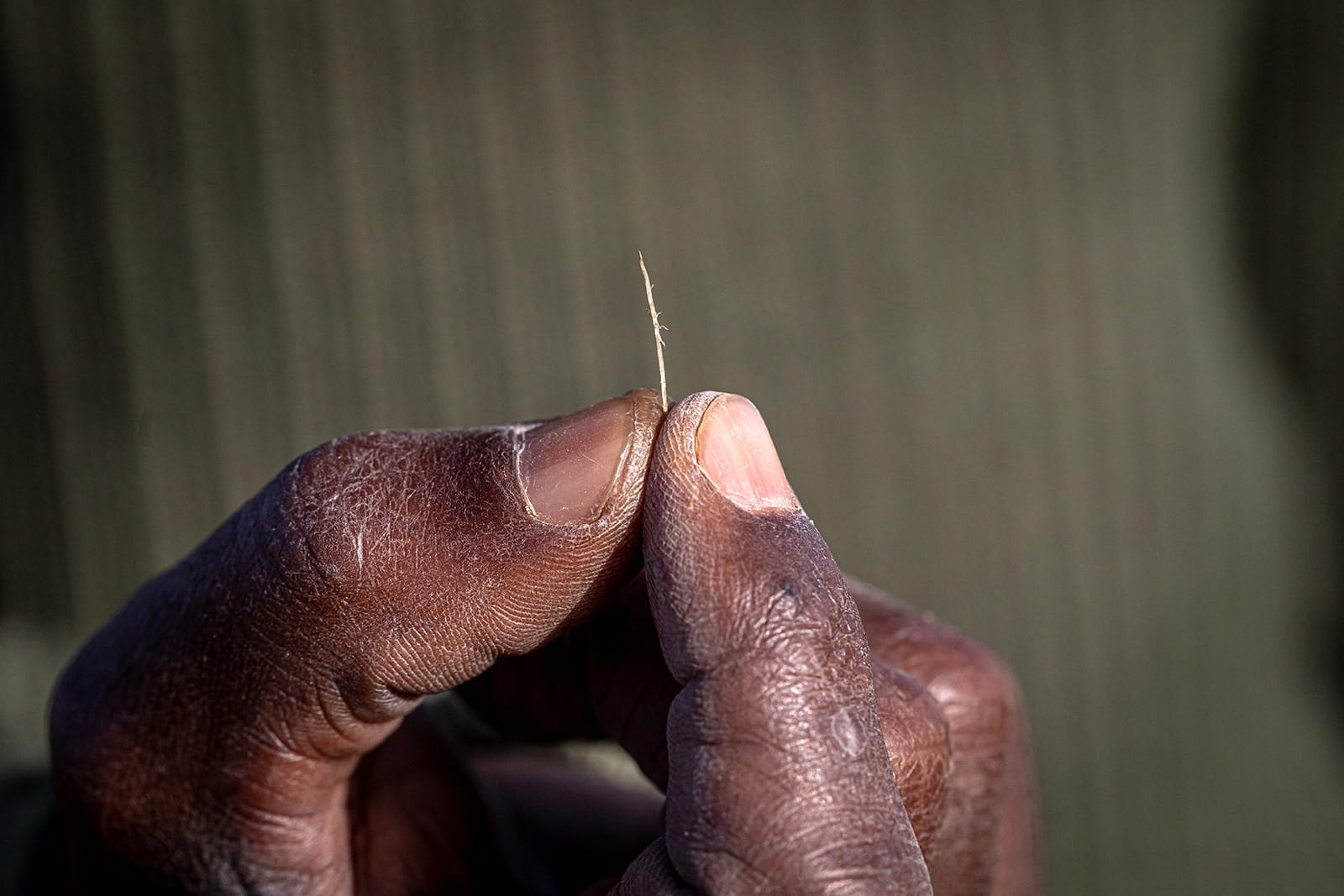
Zachary Mutai holds a fibre from Najin’s horn. Poaching saw the population of northern white rhinos fall from around 2,360 in 1960 to two today
Richard Vigne, Ol Pejeta’s CEO, believes this conjoining of livestock ranching with conservationism and tourism is the best way of combining protection and profit. “We employ about 1,000 people, we pay a lot of taxes and we’re helping to maintain the ecological equilibrium,” he says. “For our local community, this is a win-win.” But the Covid-19 pandemic has taken a heavy toll on their income. “Some 115,000 people came to visit in 2019, while last year we only saw 30,000,” says Vigne. “Our projection was that tourism would bring in around $12 million last year. It only brought in $1.6 million.” But saving the northern white rhino has become something of a higher calling. “It’s an expensive project,” concedes Vigne. “Many people are saying, ‘It’s not worth it, saving a single species while thousands of others are dying out.’ We disagree.” According to Vigne the project has already brought worldwide attention to extinction issues. “Sudan [the rhino] has been turned into a global icon,” he says. “This was a huge win for conservationism.”
While the northern white is struggling, there is cause for optimism among Kenya’s other types of rhino. In each of the past few years, the rhino population in the country has increased by 5 to 11 percent. By 2020 the numbers had risen to 1,605 from 1,441 in 2019. Last year also marked the first time in two decades that no rhinos were recorded as having been shot in the country. Sadly, the good news coming out of Kenya – where anyone caught with a rhino horn or an elephant tusk risks life imprisonment and a fine of 20 million Kenyan shillings (£132,000) – is not replicated across Africa. Over the last decade 9,885 rhinos have been lost to poaching, driven by demand in some Asian countries where their horns are widely considered to be a panacea capable of anything from boosting sexual potency and curing cancer to staving off hangovers. A kilogram of rhino horn is currently worth $65,000 on the black market in China and Vietnam.
Mutai holds up a fibre he picked off Najin’s smaller horn. “They’re hunting them for their horns, which are nothing more than the keratin our nails and hair are made of,” he says with a look of bewilderment.
At Ol Pejeta, they haven’t lost a rhino to poaching for three years although, according to Vigne, there is at least one attempt a month. But with security measures including a specialised dog unit, motion-sensor cameras and drone surveillance, he believes they are well prepared. “Most of the rhinos here die of natural causes, though you must remember that’s only because they live in a protected environment,” he explains. “Poaching is no longer our main concern. It’s lack of space.” Ol Pejeta has already surpassed its capacity for black rhinos and recently purchased an additional 20,000 acres of land from the local community for expansion.
If things go well with Fatu’s oocytes the reserve will need even more space. But even if the eggs are successfully fertilised, it is highly unlikely either Fatu or Najin will be capable of carrying them to term. “The rhinos are in pretty good health,” says Ngulu. “But their reproductive capacity is sadly severely diminished.” The vet explains how a recent ultrasound scan detected a large tumour in Najin’s stomach, near her left ovary, while a problem with her hind legs would make gestation, which typically lasts 16 months, risky. Fatu, meanwhile, was diagnosed with degenerations within her womb. If either of the pair are to contribute to a rebirth of northern white rhinos, one of their neighbours at Ol Pejeta will need to help them out.

A ranger from the anti-poaching unit with specially trained tracking dog Malaika at Ol Pejeta Conservancy
The secret sex life of rhinos
Alongside the black and northern white rhinos on Ol Pejeta live a herd of southern white rhinos. Although more plentiful than their neighbouring subspecies, the southern white rhino is still classified as ‘near threatened’. Still, the BioRescue team hope these animals can play the role of surrogate to Fatu’s offspring – although it won’t be straightforward.
Much is still unknown about the reproductive system of rhinos, and embryos inserted into southern white rhinos in the past have failed to lead to a calf. The BioRescue team’s biggest concern is timing. When exactly will the host rhino be ready for the embryo to attach to the uterus lining? Do rhinos have menstrual cycles like humans? Or are eggs released after they mate, as with some species of camels, cats and bears? The team are currently working on the rationale that they have the best chance of success if they implant the embryo after the surrogate has had sex. Although how do you avoid them conceiving a southern white rhino naturally in the warm-up process? Enter Owuan.
Owuan is a southern white rhino bull who was sterilised by the team in December 2020 and is currently cohabiting with two of the four southern white rhino females – potential surrogate mothers – in a special section of the conservatory. Owuan’s role is now to reliably indicate through his behaviour the reproductive cycle of the potential surrogate mothers without any risk of impregnating them. This information is a crucial prerequisite for transferring the embryos to surrogate mothers at the correct moment in their reproductive cycles. “We are almost ready,” says Thomas Hildebrandt, head of reproduction management at the Leibniz Institute for Zoo and Wildlife Research and one of the driving forces of the BioRescue project. “We’ll have to make an important decision soon. We’ll first transfer embryos from southern white rhinos. If everything goes well, the first northern white rhinos’ embryos will be transferred.”
Back in Italy, Cesare Galli also believes BioRescue will soon pull off the most remarkable of comebacks. “The embryos we created are alive,” he says with pride. After the egg cells collected in Kenya had been incubated and allowed to mature, 14 of them were fertilised. Four fertilised egg cells developed into viable embryos, two of which Galli holds in his hand. Liquid nitrogen keeps the embryos, along with the others already created in previous procedures, at -196C. At this temperature they could theoretically remain viable for thousands of years.
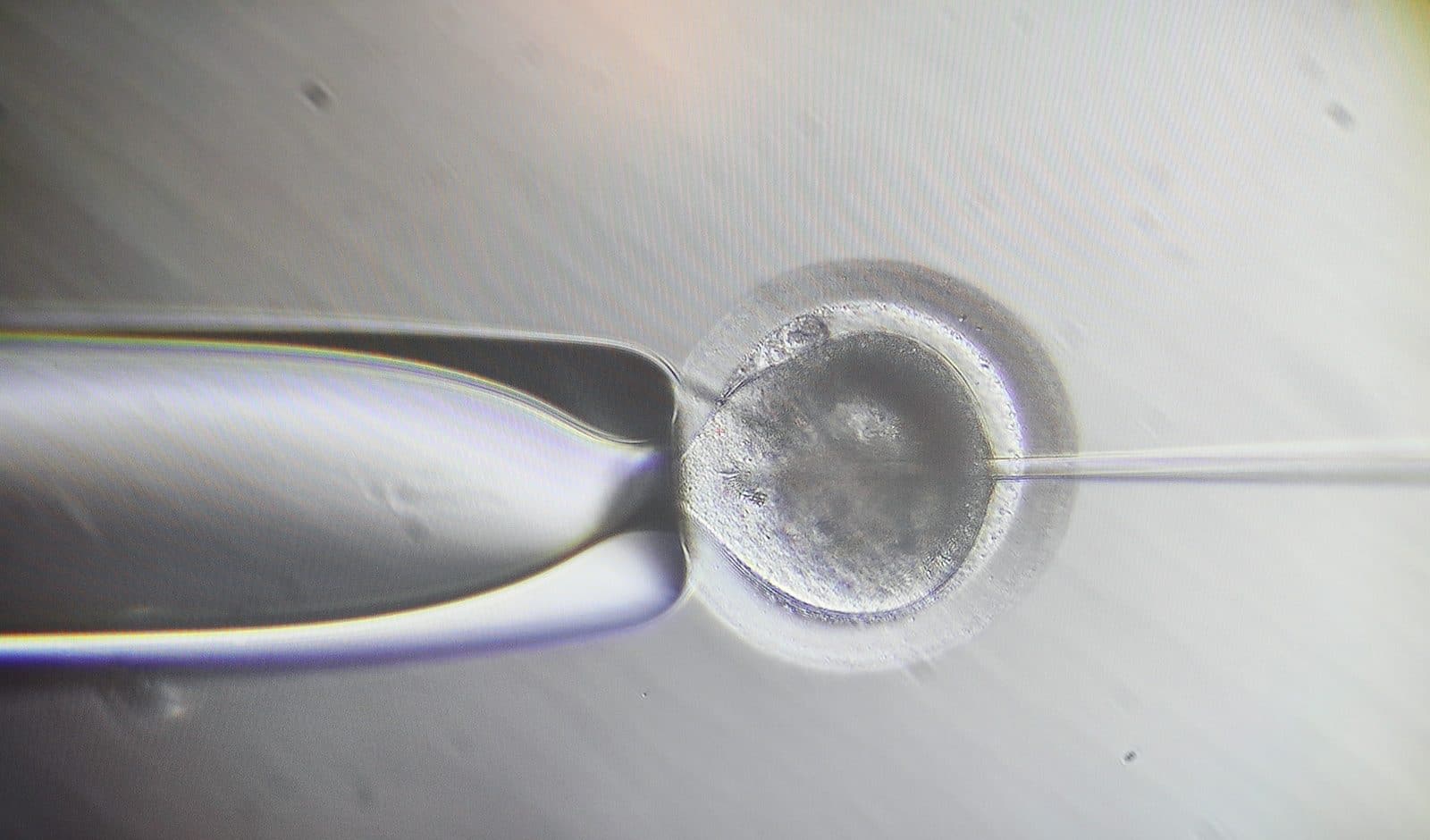
The moment of conception as a researcher at the Avantea laboratory performs an intracytoplasmic sperm injection
Galli hopes to see the first newborn northern white rhinos within five years, although the process has been prone to setbacks. “I’ve been saying that for a couple of years,” he admits. If all goes to plan Fatu, the youngest of the last surviving northern white rhinos, may yet get to nurture her offspring, teaching it the ways of the northern white in a way the surrogate cannot.
We ask Galli if it is worth it – the cost, the risky egg extraction and the sterilisation of a member of a near-threatened type of rhino in the hope that its infertile sex life will lead to surrogacy for a nearly extinct one. Should we not just give up on the northern white rhino and focus on the survival of other endangered species? He doesn’t hesitate for a second. “The danger to their survival comes exclusively from us [humans],” he says. “It is our duty to make amends.”
Slow Journalism in your inbox, plus infographics, offers and more: sign up for the free DG newsletter. Sign me up
Thanks for signing up.
